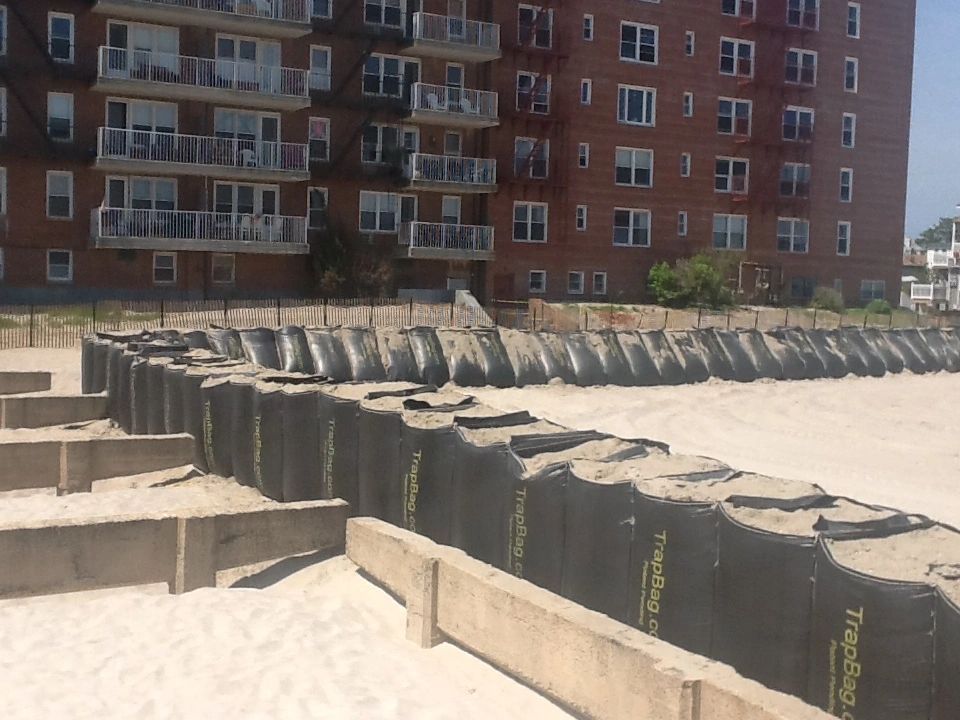In the United States, the leading cause of weather-related deaths is flash flooding. Fueled by climate change, extensive rainfall, and the failure of flood prevention systems, these natural disasters are the most common across the globe. The immense destruction and loss of life they create can be truly devastating, but this devastation can be reduced through various methods of flood prevention.
Common Flood Prevention Systems
Dams
Dams prevent water from entering a specific area. TrapBags can be used to create a temporary dam to protect areas of a city during a flood. They’re the perfect solution for short or tall dams thanks to their stacking capabilities. They’re quick and easy to install, helping you prepare fast. Plus, they require 40% less fill material than other similar products.
Dikes
Dikes are also called berms. These structures are similar to dams in that they protect land from the flow of water. Berms run parallel to the water, preventing water from overflowing onto nearby properties. With TrapBags, you can support an existing dike by raising the height or building a second layer. They can also function on their own as a dike solution, creating a structure as long or tall as you need.
Levees
During floods caused by rain or melting ice and snow, levees are used to keep water out of cities. Levees typically consist of materials like stone, soil, cement, or sandbags, but TrapBags can be installed to create a temporary levee. They’re effective and durable, offering a quick solution to protection from overflowing rivers and the need for stabilization of riverbanks.
Diversion Walls
Whether you’re creating a diversion wall solely utilizing TrapBags or building a support system for a current diversion wall, you can trust in its effectiveness. TrapBags are durable, providing five years of protection from floods.
Dune Stabilization
Dunes are a vital part of cities’ natural protection from water. As erosion, wind, and the flow of water destroy these dunes, their protective capabilities are lessened. TrapBags can be used to slow the erosion of dunes and provide more time for rebuilding. TrapBags installed in a dune’s core keep the dune more stable until other measures can be taken.
Cofferdams
Cofferdams are a type of dike built to prevent water from entering a specific area. Using TrapBags, you can create a flexible design at a fraction of the cost. Depending on water levels, TrapBags can be used to create a cofferdam in the water.
Using TrapBags to Prevent City Floods
If you’re trying to figure out how to prevent flooding in your city, TrapBags are the superior flood bag system. They can be used to slow flooding in cities and greatly reduce the destruction that occurs as a flood hits. Flash floods can come without warning, but if you’re equipped with TrapBags, you can prepare just as quickly. Use them on their own or to strengthen your current flood prevention system.
Benefits of TrapBags
TrapBags are a versatile solution with many benefits. As the superior flood barrier method, you can count on them for their:
- Durability: Created with high-strength textiles, TrapBags are durable against water and debris. They can withstand flood water as well as the wind and mud that come with it. Trust in TrapBags to last at least five years.
- Versatility: TrabBags can create a wide range of flood barriers or be used alongside them for added strength. The 50-foot sections can be connected as needed across any size area. Permanent solutions can be created when filled with concrete, or temporary solutions when filled with sand or gravel.
- Simple installation: TrapBags are easy to install, and their simplicity makes them the faster solution. Filling them is also simple and can be completed quickly in the event of a flood.
- Cost effectiveness: Because they don’t require heavy machinery or additional labor, TrapBags are the more cost-effective flood barrier solution. They also require 40% less fill material than other products.
- Rapid deploy: In just 30 minutes, you can install nearly 100 linear feet of TrapBags. This is the equivalent of about 8,000 sandbags. This flood prevention method works fast.
Other Ways to Prevent Flooding in Cities
Erosion Control
The erosion of beaches, dunes, and other land can lead to floods reaching homes and businesses. It can also create more devastating damage with the debris and mud that comes with the flood. From soil and cliff erosion to coastal shoreline erosion, TrapBags are a low-cost erosion prevention method that can protect your city from floods.
Sponge Cities
Sponge cities are city areas with plentiful natural resources to absorb and slow flood waters from reaching communities. From plains and marshes to parks and fields, the additional land acts as a sponge in event of flooding. TrapBags can be used to protect these areas and further slow the advance of oncoming floodwater.
Vegetation Efforts
Similar to sponge cities, vegetation in cities can slow the impact of floodwater. Additional vegetation can also absorb water before it reaches inhabited spaces. TrapBags can protect a city’s ongoing vegetation efforts while also serving as a flood barrier.
Community Education
Educating your community on how to prevent floods and what to do in the event of flooding is a major component of saving lives and property. This includes items like explaining why it’s important to protect drainage systems and discussing how flood barriers work and what steps need to be taken before a flood hits. If your community knows how TrapBags work and where they’re going to be implemented, residents and businesses can be more prepared.
Protect Your City with TrapBag Flood Barriers
TrapBags are a great way to enhance your city’s protection against floods and the devastating effects they bring. Find out how to prevent floods from reaching your city’s infrastructure and communities by reaching out to TrapBag for details.


